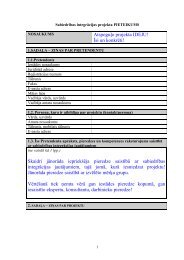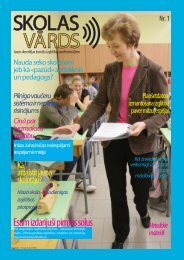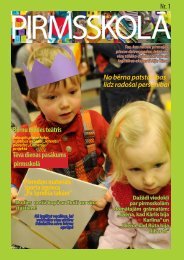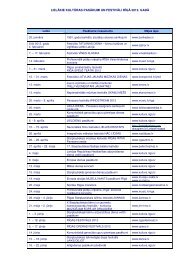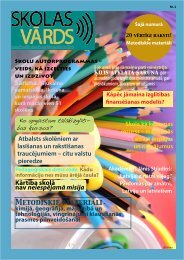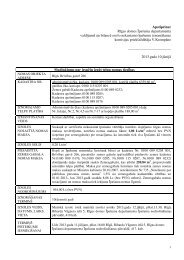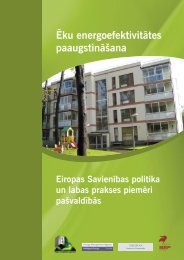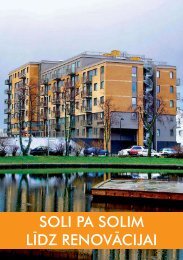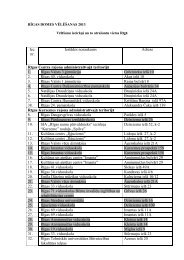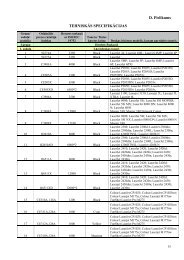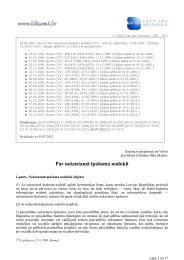Riga - European Capital of Culture 2014 candidate
Riga - European Capital of Culture 2014 candidate
Riga - European Capital of Culture 2014 candidate
- No tags were found...
Create successful ePaper yourself
Turn your PDF publications into a flip-book with our unique Google optimized e-Paper software.
the cities <strong>of</strong> the ancient Amber Route. Thissharing <strong>of</strong> experience and knowledge willlead to an act <strong>of</strong> cohesion, surprising thoseinvolved and contributing to the creation <strong>of</strong>new achievements and cultural events.Pliny once wrote about a Roman nobleman(eques), who was sent by the patricianJulian to Prussian shores in order to bringback large amounts <strong>of</strong> amber. Scholarshave argued about whether this Roman noblemantravelled to Prussia simply to bringback amber, or whether he also went thereto discuss the introduction <strong>of</strong> a unified customsduty, which would lessen the manycustoms duties imposed over the course<strong>of</strong> the long journey. 2 <strong>Riga</strong>’s “New AmberRoute” partnership project is an attemptto break down the boundaries erected bystereotypes (the ‘typical’ Northerner, or the‘typical’ Southerner), and to bring togetherpeople from various spheres for new culturalexperiences and events. The projectalso aims to create, through new culturalnetworks, a type <strong>of</strong> modern cultural ‘currency’:high-quality partnership projects,which are marked by excellence and theability to fascinate the minds <strong>of</strong> many andimprove the quality <strong>of</strong> life.Cities in the “New Amber Route”cooperation network 3Cities in the Northern-Western-SouthernAmber Route partnership:<strong>Riga</strong> – Liepāja – Klaipēda – Kaliningrad(Königsberg) – Gdansk – Lübeck – Bruges– Vienna – Aquileia in the province <strong>of</strong> Venice– Rome – Athens.1The working group based its studies <strong>of</strong> the AmberRoute on research by Latvian and internationalhistorians. Of particular assistance were the studiespublished by the International Conference onAmber in Archaeology, in Talsi, Latvia, in 2001, andthe highly acclaimed book “Ancient Amber Routes”Waterways: Baltic Sea, Vistula – Morava –Danube; Elbe – Rhine – Rhone.Cities in the Northern-Eastern-SouthernAmber Route partnership:<strong>Riga</strong> – Rēzekne (in association with the nearbyLake Lubāna marshes) – Daugavpils –Sevastopol (formerly Chersonesus) – Istanbul.Waterways: Daugava – Dnieper – Black Sea.Different fields in the “New Amber Route“cooperation network and expedition<strong>Culture</strong> – Inspired by the many uses <strong>of</strong> amberin various cultures throughout history,the “New Amber Route” opens up the opportunityfor projects in and between variouscultural sectors, including, but certainly notlimited to, the fields <strong>of</strong> art, fashion, design,music, textile art, archaeology, literature, andphilosophy.Business – The Amber Route, as has beenmentioned several times, ensured the lifelinefor commercial transactions in varioustime periods, throughout the <strong>European</strong> continent.The “New Amber Route” <strong>of</strong>fers tocollaborate in the process <strong>of</strong> sharing economicknowledge and supporting creativeindustries.Science and medicine – Scientists haveconfirmed the healing properties <strong>of</strong> thisvaluable mineral. Artwork and cultural experiencesinspired by physics are currentlyvery actual in the world <strong>of</strong> art and multimedia.In this context, the relationship betweenculture, medicine, and chemistry has a future,especially taking into account society’sgrowing interest in ‘eternal youth’ and othermatters related to public health.and the Geographic Discovery <strong>of</strong> the Eastern Baltics(Zelta ābele: Stockholm, 1962), by Pr<strong>of</strong>essor ArnoldsSpekke. We would like to express our gratitude toIlze Loze, <strong>of</strong> the Latvian History Institute, and Dr.Māra Kalniņš, pr<strong>of</strong>essor at Corpus Christi College,University <strong>of</strong> Cambridge, for their generous support.Climate Change – The conditions thatbrought about the creation <strong>of</strong> amber highlightthe importance <strong>of</strong> climate change. Itseems as if the relationship between cultureand climate change could heat up, asglobal discussion and activity regardingclimate change and environmental issues inthe twenty-first century continue to grow.Person to Person – This dimension <strong>of</strong> the“New Amber Route” provides for closer contactbetween individuals. It also foresees theeradication <strong>of</strong> superficial impressions anderroneous stereotypes about people in thenorthern and southern parts <strong>of</strong> the continent.The results <strong>of</strong> other projects in the afore-mentionedfields reach their culmination, their ‘dayin the limelight,’ by involving a wide range <strong>of</strong>people from local society. This perspectivereflects, in modern form, the people by theBaltic Sea described in ancient Roman texts,as well as their unique customs and rituals.Schedule for the “New Amber Route”cooperation network2009–2010 – Research <strong>of</strong> possible cooperationprojects and initial contact with cities.2011 – Basic development <strong>of</strong> projects; reinforcement<strong>of</strong> direct contacts with peopleinvolved in projects; budget approval.2012–2013 – Project development and finalization.<strong>2014</strong> – Project implementation, withinthe framework <strong>of</strong> the <strong>European</strong> <strong>Capital</strong><strong>of</strong> <strong>Culture</strong> programme, in <strong>Riga</strong> and othercities involved in the “New Amber Route”project; exploration <strong>of</strong> future possibilitiesfor the project; contact with upcomingECC cities.2Spekke, Arnolds. Ancient amber routes andthe geographic discovery <strong>of</strong> the Eastern Baltic.Stockholm, 1962. p. 58.3Other cities may become involved over the course<strong>of</strong> the project.one day in europeA single 24 hr period in the life <strong>of</strong><strong>European</strong> member states, which issimultaneously recorded, in all theparticipating countries, through thelenses <strong>of</strong> thousands <strong>of</strong> pr<strong>of</strong>essionalphotographers and hundreds <strong>of</strong> thousands<strong>of</strong> amateur photographers.After the campaign, the photographswill be featured in many travelling exhibitions,thereby strengthening theinternational connections forged duringthe campaign.The international photo campaign “One Dayin Europe” is a photo project <strong>of</strong> unprecedentedscale in Europe. It will not only provide achance to create and strengthen an internationalcooperation network in the photographyfield, but will also inspire <strong>European</strong> citizensto look at the distinctive features <strong>of</strong> theirhome country through the camera lens. Thisproject not only tears down boundaries andunites practitioners and enthusiasts fromthe photography field, it also provides inspirationto record and appreciate that which isdifferent about each specific place, as wellas to repeat this unique experience after fiveor ten years.The photo campaign “One Day in Europe”<strong>of</strong>fers a chance to record, through thecamera lens, the peculiarities <strong>of</strong> theAmber Route, on each stage <strong>of</strong> its path.The campaign unites practitioners <strong>of</strong> thephotographic arts by tearing down andexpanding existing boundaries, inspiringand attracting young talent, and creatingan international and enduring culturalproject. In this project, Latvia is not just amember state and <strong>Riga</strong> is not just a city;they are both the initiators and organizers<strong>of</strong> the project and the centre <strong>of</strong> the action.This is an international photography campaignthat will combine both pr<strong>of</strong>essionaland amateur photographers.Like the photo campaigns “One Day inLatvia,” organised in 1987, and “One Dayin Latvia: Twenty Years Later,” in 2007, theaim is to record or document a single day –24 hrs in the lives <strong>of</strong> the participating countriesthrough the camera lens, accordingto previously established methodologicalprinciples. If all goes according to plan, thecampaign will be repeated after five or tenyears. In this way, the project will achievenot only artistic results but also a historicallysignificant documentary <strong>of</strong> a specifictime, revealing the individuality and distinctiveness<strong>of</strong> each nation.What: International photo campaign.Where: Planned campaign locations include:a) all countries in the Baltic Sea region,b) all <strong>European</strong> Union Member States.The number <strong>of</strong> states participating in thecampaign is largely dependent on the capacities<strong>of</strong> the partner organizations andthe amount <strong>of</strong> EU funding.The organizational and principal coordinationpoint <strong>of</strong> the campaign will be <strong>Riga</strong>. Incollaboration with the partner organizations,the organizers will formulate basicprinciples according to which routes willbe planned for the pr<strong>of</strong>essional photographersand themes will be developed forthe amateur photographers.When: The international photo campaign isplanned in two stages:1. Pilot Project.One 24 hr period in the year 2011, sometimebetween May and September. Followingthe pilot project, the photo archive accumulatedduring the event will be used tocreate a travelling photo exhibition and topromote publicity for the <strong>2014</strong> photo campaign.2011 marks the sixtieth anniversary<strong>of</strong> the founding <strong>of</strong> the <strong>European</strong> Union.2. International photo campaign “One Dayin Europe”The time period for the campaign is a single24 hr period in <strong>2014</strong>, sometime betweenMay and September. Project participantswill include pr<strong>of</strong>essional photographers,amateur photographers, and photo enthusiastsfrom the participating countries.Photography pr<strong>of</strong>essionals from each participatingcountry will be given previouslyplanned routes, and the photographers willbe divided into two groups:Group 1 will record events in a participatingcountry other than their own during the24 hr period (similar to the pilot project).Group 2 will record events in their owncountries during the 24 hr period.Photo enthusiasts and amateurs will recordevents in their own country over a 24-hour period,choosing one or more <strong>of</strong> the previouslydeveloped themes. After the photo campaign,all the photo materials will be collectedfrom each participating country; these materialswill then be processed and systematizedand used to create the exhibitions.Concept authors: Ilmārs Znotiņš, ViestursKoziols, and Daiga Livčāne. AssociationViena Diena.lv.www.vienadiena.lv.Organisers: Association Viena Diena.lv.In addition, in preparing the campaign,cooperation will be established with<strong>European</strong> Union financing foundations, aswell as with <strong>Riga</strong> City Council, Ministry <strong>of</strong><strong>Culture</strong> and the Ministry <strong>of</strong> Foreign Affairs.Cooperation Partners: Pr<strong>of</strong>essional photoorganizations, city and state institutions, andbusinesses in the participating countries.112 113



